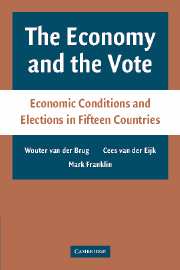Book contents
- Frontmatter
- Contents
- Preface
- Introduction
- 1 Studying Economic Voting
- 2 Party Choice as a Two-Stage Process
- 3 Hypotheses and Data: The Theoretical and Empirical Setting
- 4 Effects of the Economy on Party Support
- 5 The Economic Voter
- 6 From Individual Preferences to Election Outcomes
- 7 The Economy, Party Competition, and the Vote
- Epilogue: Where to Go from Here in the Study of Economic Voting?
- Appendix A The Surveys Employed in This Book
- Appendix B Detailed Results Not Reported in the Main Text
- References
- Index
Appendix A - The Surveys Employed in This Book
Published online by Cambridge University Press: 18 December 2009
- Frontmatter
- Contents
- Preface
- Introduction
- 1 Studying Economic Voting
- 2 Party Choice as a Two-Stage Process
- 3 Hypotheses and Data: The Theoretical and Empirical Setting
- 4 Effects of the Economy on Party Support
- 5 The Economic Voter
- 6 From Individual Preferences to Election Outcomes
- 7 The Economy, Party Competition, and the Vote
- Epilogue: Where to Go from Here in the Study of Economic Voting?
- Appendix A The Surveys Employed in This Book
- Appendix B Detailed Results Not Reported in the Main Text
- References
- Index
Summary
The empirical data for most analyses in this book derive from the European Elections Studies (EESs) from 1989, 1994, and 1999. These were survey-based studies of the electorates of the member states of the (then) European Community (EC) in 1989 and of the European Union (EU) in 1994 and 1999. In all years, the surveys were conducted immediately following the June elections to the European Parliament. In 1989 and 1994 all twelve member states were surveyed, and all fifteen in 1999. The member states were (in 1989 and 1994) Belgium, Denmark, France, Germany, Greece, Ireland, Italy, Luxembourg, the Netherlands, Portugal, Spain, and Britain; and in 1999 additionally Austria, Finland, and Sweden. The questionnaires of the surveys focused in particular on the direct elections to the European Parliament, and contained a large number of items about political topics in the domestic and European political spheres.
The EESs were designed as stratified samples of the European population, in which each of the member states is a stratum. Although technical aspects of the sampling procedures varied somewhat between the various years and between the countries, all surveys were based on random samples from the electorates in each of the countries. Sample sizes varied likewise and are reported in Table A.1. Owing to missing data on the dependent variable (propensities to vote for parties), the number of cases included in the analyses is somewhat reduced, to 32,950 (in the weighted sample – about weighting, see later).
- Type
- Chapter
- Information
- The Economy and the VoteEconomic Conditions and Elections in Fifteen Countries, pp. 201 - 206Publisher: Cambridge University PressPrint publication year: 2007



